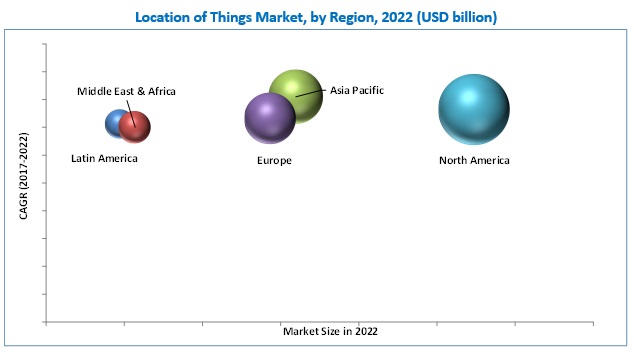Increasing importance of spatial data; commercialization of Location based services; democratization of geospatial data for IoT applications; and increasing use of location-based applications across different industry verticals are the key factors driving the growth of this market.
Internet of Things (IoT) acts as an unprecedented tool to bring business transformation and business disruption. IoT enables organizations to achieve efficiency to their existing business processes. Furthermore, adding a Where and when component to IoT utilities adds new context to the information. Location of IoT or location of things or Geo IoT encompasses the ability of “things” to detect, communicate and analyze their geographic position.
The location of things market has been segmented, on the basis application, into mapping & navigation; location-based customer engagement & advertising platform; location-based social media monitoring; IoT asset management; and location intelligence. The market for IoT location intelligence application is expected to grow at the highest CAGR between 2017 and 2022, owing to increasing use of IoT location intelligence as a tool to get competitive advantage and make insightful business decisions. Furthermore, increasing use of IoT location intelligence for mobile advertising, business planning, and social media marketing has fueled the market growth for the segment.
The location of things market in Asia Pacific is expected to grow at the highest CAGR during the forecast period. The geospatial industry across economies such as India, China, Japan, and Malaysia, The Philippines, and New Zealand are undergoing massive transformation. The government across these regions are highly investing in various projects related to the deployment of location-based services and infrastructural projects to promote productivity and economic growth. These factors in turn fuel the location of things market in this region.

Increasing use of location-based applications across different industry verticals drive the growth of location of things market
Government & Public Utilities
Government & public utilities have started using the location of things to exploit the geographic location intelligence. Location-based technology helps integrate location intelligence software with geospatial, IoT, and business data, such as census data, tax information, and video surveillance files. The integration of GIS and interactive mapping technology offers comprehensive solutions for facilities and workforce management. Government & public sector typically operate in an environment marked by severe resource constraints, along with requirements to maintain accountability while observing data security regulations. The sector contains a lot of personal data of users from different regions; the technology will help them streamline the processes. Location-based technologies help the government in the U.S. during elections and redistricting. Oil & gas and mining organizations use location-based solutions to drive operational efficiencies, reduce costs, increase sales & marketing, and manage quality, safety, and risk through the IoT connectivity when integrated with location-based technology. It provides real-time visibility, evacuation monitoring, employee visibility, distress alerting, access control, and gas exposure detection. These systems also track and record the movements of engineers and workers on rigs & mine's based out of different parts of location, and can also save lives of workers using the technology.
Retail
Location of things in retail can be defined as an interconnected system of devices and sensors that retailers use to streamline business through identifying the location of inventory, assets, and even human resources. Thus, location-based solutions are becoming necessary for retailers to understand customer requirements and their purchasing behavior, for improving business strategies and operations to provide a better customer experience.
Transportation & Logistics
The industry requires a transparency and real-time visibility of its activities, which includes asset management, warehouse management, inventory control, workforce management, and transportation. In transportation & logistics, location-based solutions when integrated with IoT technology will improve the operations and business processes. Location-based technology helps optimize transport routes by integrating valuable information such as the property of the vehicle, road network & traffic regulations, and expected delivery time. The technology contributes to the more efficient use of fleet management by increasing the number of distribution points for routes that have extra capacity. In this sector, the technology is used for network planning, actionable operational intelligence, and sales & marketing.
Defense
Location-based technology is widely adopted by the defense sector across the globe for asset tracking & management develops systems and metrics to track location & performance of service military personnel, defense fleet vehicles, and other service assets. All the assets are well equipped with IoT connectivity, resulting in real-time monitoring of all the defense equipment. Location-based data can be used by firms in the defense sector to optimize the execution of service delivery, by helping them allocate their resources required for field services. Asset and defense personnel tracking & management is the ability to measure the benefits of technology deployment and use the results to improve key internal processes. A sophisticated GIS with the help of IoT connectivity, enriched with visualization and analytic tools, can help in gaining better insights. The location of things in this vertical include high-performance algorithms that search through data for geographical behavior and time-based patterns.
Key players in the market include Bosch Software Innovations GmbH (Germany), Google, Inc. (Alphabet, Inc.) (US), IBM Corporation (US), Microsoft Corporation (US), ESRI (US), Qualcomm Technologies, Inc. (US), Wireless Logic (UK), Ubisense Group Plc (UK), Pitney Bowes (US), HERE (US), Telogis (US), TIBCO Software, Inc. (US), GoBabl (US), Zebra Technologies (US), Awarepoint Corporation (US), Navigine (US), and Geofeedia (US). These players are increasingly undertaking mergers and acquisitions, and product launches to develop and introduce new technologies and products in the market.
To speak to our analyst for a discussion on the above findings, click Speak to Analyst
No comments:
Post a Comment